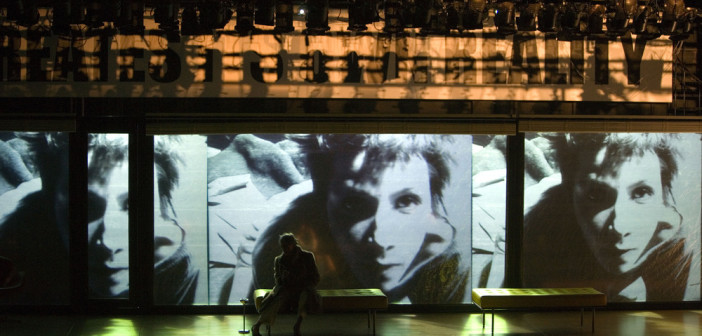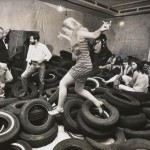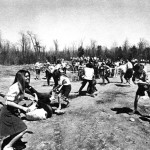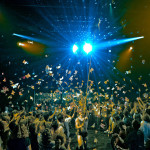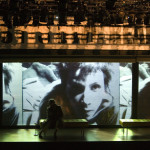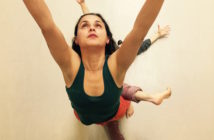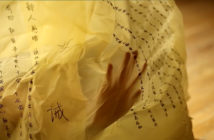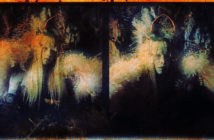To be a performance artist, you have to hate theatre. Theatre is fake: there is a black box, you pay for a ticket, and you sit in the dark and see somebody playing somebody else's life. The knife is not real, the blood is not real, and the emotions are not real. Performance is just the opposite: the knife is real, the blood is real, and the emotions are real. It's a very different concept. It's about true reality.
—Marina Abramović
The whole of life of those societies in which modern conditions of production prevail presents itself as an immense accumulation of spectacles. All that once was directly lived has become mere representation.
—Guy Debord
Imagine for a moment that I were to follow the convention of essay-writing, and say nothing about the quotations below the title. The juxtaposition of the quotations would speak for itself, and I wouldn’t need to explain them to you. Abramović’s is a kind of irritated echo of Chris Burden’s more elegantly protracted and pleasantly ambiguous "bad art is theater," and sets up a feeling of serious exception to the fakery of play-acting. Then Debord’s (taken from a book that Abramović has surely read and likely agreed with) saying that, on the contrary, everything in commercialized society operates like theater. Because of the arrangement of these texts, because Debord gets the last word, so to speak, a narrative is created about an idea. Arranged in the opposite order (Debord first, Abramović second), one would be more likely to suppose that she was just speaking to elaborate his point.
Try reading it that way.
By the time you finish with Abramović’s longer quotation, Debord’s point has dissolved itself through her polemic, and her practice seems to be a reaction to the situation he describes. Of course, this is the way she would like her work to be understood. Looked at in the arrangement above, however, something different is communicated. The brevity, the analytical voice in Debord seems to patronize Abramović’s emotional language, and his statement about the whole of those societies obviously includes her real knife, real blood and real emotions (which, we suddenly remember, we tend to encounter in a real art gallery). Because we know who Marina Abramović and Guy Debord are, and know that they tend to exist within similar realms of discourse, what comes across is the effect of undercutting her positivity with her own citation. But uneasily, of course—because they are both figures we want to respect. And it’s possible to evoke that subtlety because it doesn’t need to be stated outright—it is shown, not told; like a story. The smirking realization drifts into consciousness through the exaggerated characters of these two statements, which might even act upon uneasy (but still active) stereotypes of belief that are particularly potent in binaries of male vs. female and the theorist vs. the practitioner. None of these things is the issue at hand, of course, and I don’t have to make any statement that references any ugly opinion about them. But, put next to each other, all of this plays.
This is the kind of methodology you learn by studying drama. There is a temporal structure to ideas, and it shows to different advantage according to characterization, feelings and timing. "Theater is the most time-serving of forms," says Herbert Blau, "literally, functionally, and metaphysically. It is by nature unreliable."1 It’s a running joke about Shakespeare’s plays: the way people recite with great solemnity lines that are given to Polonius, or with great magnanimity the ones given to Iago. It is not a simple task to read the plays and know what Shakespeare means—that’s why the plays are plays. Nevertheless, Shakespeare will forever be cited as The One Who Said It, especially on badly-designed websites that list famous quotes and give your computer a virus. Theater relies on text, often upon texts that come from other people, other time periods, even other centuries. This sometimes seems strange to artists who work in other mediums. Perhaps it looks as if the relation to another historical moment and the pieces of literature lifted from it means that there is no authentic creative act involved in theater; that it is purely mimetic, and that there is only a kind of specialization about doing it correctly and believably.
But believability was never simple. Aristotle says that mimesis, and pleasure in imitation, is one of the fundamentally important things about art: that it represents something, and that we recognize in the representation the imitation of something real, and take pleasure in that recognition. But this doesn’t mean that theater is like a painting of an apple. Where actors, under the guidance of directors and designers, are trying their best to look like apples in order to become the painting that was basically completed by a playwright hundreds of years ago—though sometimes people claim they would be happier if it worked this way—often bad productions operate on about this level. We ought to remember that believability, in terms of experience, involves a more complex mode of mimesis. Keir Elam in his Semiotics of Theatre and Drama tries to break believability down by talking in terms of the signifiers involved in drama, but I don’t agree that the germ of what makes these things work can be parsed so easily. If it could, we would actually be affected by seeing Hamlet in his pajama pants, or Mercutio dying of a gunshot wound, or any other odd, modernized costume and prop choice that a director assumes will make his piece relevant.
Believability should not be confused with naturalism, a relatively new idea, which itself is suggestive of a particular kind of behavior, anchored in a particular period. We often believe things that are extremely unnatural, particularly when they happen. But Allan Kaprow took issue with theater, because it was part of the realm of what he called "artlike art," art with a frame. Kaprow managed to describe some key properties of theatre when he described his Happenings, though—even as he told us why they were not theater. "A play assumes that words are the almost absolute medium. A Happening frequently has words, but they may or may not make literal sense."2 available in full here Not literal sense, but some other kind of sense. Like poetry, of which, Aristotle need hardly remind us, drama is a form.
…Light thickens; and the crow
Makes wing to the rooky wood:
Good things of day begin to droop and drowse
While night’s black agents to their preys do rouse.
(Macbeth III ii)
Pasadena edition with participants.
Photo ©Julian Wasser, via eluxury.com
What does that mean, literally? At best, you will be able to say that it refers to one or several birds, doing one or several things in the woods, as a metaphor for a particular state of mind and feeling about the world, which it is perhaps up to the actor to interpret, but which he is ultimately obliged to say anyway. Because of the way it feels to hold the words in his mouth and his mind, the way the sounds of the words (literally) make a part of your body vibrate in the audience, the plot of the play, the character speaking the text, the personal and political situations surrounding your attendance that evening at the theater . . . something happens. All of which may or may not make literal sense as it gives you goose-bumps. Of course it matters little that this doesn’t make literal sense, for ". . . lifelike art makers' principal dialogue is not with art but everything else, one event suggesting another."3 Just the way a play (often lifelike in a way Kaprow does not mean, but might) suggests and includes the events that surround it; other moments worthy of goosebumps, for example.
Why the architecture of theaters is important: the experience of approaching a building and entering it is theatrical, and it links the experience inside to the experience outside. Walking up a grand staircase opens every performance at the Opera de Paris. Later, some companies set up retreats in the provinces, where a journey away from the urban center and into the landscape provided the same sort of experience of strange escape. But "the line between the Happening and daily life should be kept as fluid, and perhaps indistinct, as possible," Kaprow says4. Kaprow's line, from the lexicon of his own art, is too easily imposed on other practices. A glorious building, a grand staircase, a journey; these are all a kind of invitation, a call to adventure. The building is a part of the city and its activity; the retreat is a destination and a gem that lures us. But erecting around these escapes the idea of a "line", separating them from reality? In a way it is true, but it fails to recognize that the unreal is as much a part of our reality as the non-literal is a part of our language. It impoverishes experience.
Something about this flatness, which tends to reduce life to "daily" life, always brings with it the suggestion that time operates in a certain way, and so blinds us to the reality that across time and space, time and space seem to change. This is why it is so confusing to go through enormous human experiences like falling into deep depression, or out of it, or in love, or out of it, or becoming convinced by a particular ideology. Suddenly, your established laws of experience are no longer valid. Time moves more slowly, or more quickly. It focuses itself on particular places and events. You feel incapable of moving in certain ways, and unable to avoid certain others. Geography and time reorganize around your attention, which is chaotic, and evidently governed by strange forces. Plays offer a rehearsal of this type of experience: subjunctive structures for changes in the structure of reality. And watching a performance can enact one of these changes; a play always includes the real experience that surrounds and includes it, so that rather than excluding "true reality" it throws "true" reality into high relief. The play draws upon real experiences as metaphors and contrast, and establishes legible metaphors that experience will refer to later on. Leaving the hothouse botanical garden, the trees on the highway are strange specimens from another climate.
When we realized that we were living in the society of the spectacle, though, theater became a derogatory term for the banal, deceptive and risible; in a shift of thinking reminiscent of mistrusting the greenhouse because of findings about the greenhouse effect. Particularly under a proscenium arch (for special exceptions could occasionally be made for anarcho-experiments like Paradise Now, where you could be fondled by a troupe of nomadic actresses and actors in nude-colored loincloths), "traditional" theater began to look both evil and particularly, like, uncool to serious artists, particularly in the United States. Even today it is not only avoided, but genuinely hated by people like Marina Abramović, who has been known to cast actors to re-present her work. With all due respect, a deeper question about the practice of theater is not whether we should hate it, but why it might have happened at all. The proscenium stage is a bizarre development indeed: an artificial definition between the seer and the seen. To throw a curtain onto it suggests further insanity. One can only imagine it to have been an outgrowth of a society that was obliged to acknowledge, indeed invent, the idea of spectacle. Of course, the Greeks didn’t despair of the separation: they built it a temple. Or rather, they built a space where "practical theory exercises control over itself and surveys its own action," as Debord calls us to do.5 But only in fiction can theory really exercise control. And only by inventing actors could it step outside to survey the action. This is one of the differences between theory and practice: an idea might involve a point-blank rejection of other ideas. An action (or an utterance) must integrate with other perspectives in real time. Theater involves interjections into other experiences, and is fundamentally about different kinds of coexistence.
It also can’t be talked about too much. The greatest statements of principle in theatrical enterprise tend to take a kind of histrionic form, like this: In the late 1950s, Sir Tyrone Guthrie was an imposing figure in the theater world; widely recognized as a genius and visionary, with a 6’3" frame to match. He was sojourning in the middle-western United States, seeking a new home for a new theater: a thrust stage ("sticking it to the audience" says Herbert Blau). Glorified by international fame and sanctioned by the British knighthood, Sir Guthrie arranged himself in the brightest light at the Cleveland Playhouse. His presence took the space, and addressed the assembled staff. "Seek out the protective umbrella of colleges and universities," he urged.
At the time, small regional theaters had yet to seek the status and security of the universities, and it seemed relevant to Sir Guthrie to issue this kind of gesture against the "tawdry commercialism" of Broadway. The idea was sensible. The resident companies needed resources and security while the university drama departments (if they were to produce employable actors) needed an injection of some kind of professionalism. But Guthrie’s statement, honestly enough, was from the perspective of the companies: It suggested a method of making theater in the United States that would shield artists from pure commercial motives, while keeping them afloat without the government subsidies enjoyed in Canada and the UK. Interestingly, Guthrie made clear that this goal was really about preserving the theaters themselves, forming a national tradition around them, and beginning to enrich standards of performance education to something closer to classical music or dance. In 1963, the Guthrie Theater was founded in collaboration with University of Minnesota in Minneapolis, "a resident acting company that would produce and perform the classics in an atmosphere removed from the commercial pressures of Broadway." Of course the university was a tool, "the ‘open sesame’ spelled by ‘education’" as Lincoln Kirstein put it. But naturally Guthrie needed some sort of tool, if he wished (as I think he did) to re-shape the role of theater in American culture. Before 1963, there were few resident companies to speak of. It was only in 1967, four years after The Guthrie opened, that the companies were documented at all, and in the ten years following, the number doubled. They were to the 1960s and 1970s something like what MFA writing programs became for the 1990s.
In 1980, near the end of the boom, Robert Brustein founded American Repertory Theatre. A.R.T was Harvard’s first professional resident company, and Brustein’s second (in 1966, he had founded the Yale Repertory Theater in New Haven). He chose not to call the new company Harvard Rep, which communicates to me (along, probably, with the desire to push the company to the top of alphabetized lists) a kind of ambivalence about the resident company’s connection to the university. Brustein had been burned at Yale; he was released from his position by A. Bartlett Giamatti, a faculty member from the days before Brustein’s tenure who harbored nostalgia for real job security in the drama department, and dislike for the modernist aesthetic favored by Mr. Brustein, which wasn’t very nice to the sacred proscenium, or authorial intent. With the termination of his contract at Yale, Brustein found himself mourned in the press: the excellence of his productions was praised in the New York Times and Newsweek, his graduates were the toast of Broadway, his program had been "a major source of talent for . . . the theatre at large", and his dismissal was "a blow to the entire American professional theatre."6 He had landed in a sweet spot: too wild for the university to contain, and too famous for it to ignore. He had been praised as an educator, an experimental mind, and a contributor to American theater as a whole. And he had already said a lot of very principled things:
. . . the principle of arguing from the audience’s point of view prepares the way for any meretricious piece of goods on the pretext that more ambitious ventures will naturally follow. I seem to remember television producers, years ago, claiming heatedly that quiz shows and situation comedies would make it possible for quality plays to appear regularly on the networks. We are still waiting. The brute fact is the bad invariably drives out the good.7
Not Harvard Repertory Theatre. American Repertory Theatre. A.R.T., which, as the brightest have noticed, spells art, even though Chris Burden had already figured out several years earlier that bad art is theater, and so on. Of course only the brazenly distant from the art world would ever use such an acronym. I will defer to David Levine on this point:
I mean—what are you going to do? Modernists couldn’t stand theater because it lacked autonomy; 70s artists couldn’t stand it because it was too representational; Steven Henry Madoff, batting for the present day, doesn’t like it because it’s too autonomous, and the general art-going public doesn’t like it because (a) it’s, like…cheesy, and (b) who would want to pay money to be trapped in a dark room watching people emote for two hours when you can go to Deitch Projects, drink for free, see the Citizen’s Band, wonder aloud why the fuck these performance guys don’t ever rehearse, and leave whenever you want? Seriously.
Good theater=Bad art.
Good art=Bad theater8
So when Robert Woodruff, Brustein’s hand-picked successor, was accused by his detractors of producing bad, unwatchable theater, perhaps he was producing something that verged on performance, or utilized aesthetic preferences popularized in the European avant-garde (particularly Berlin), where the division between these practices doesn’t seem so sharp, and where theatrical productions tend to involve more conceptual rigor. To be sure, something about his approach fulfills one interpretation of A.R.T.’s mission statement - "to expand the boundaries of theater!" But profitability became a damning question, and (the ghost of A. Bartlett Giamatti demands, howling) what does this unthinking preference for the avant-garde mean for tradition? What does that mean for the audiences and playwrights, who just want to see the play done correctly? If we are to be forced to watch a performance-amalgam of people in a mud pit in pajamas approximating Shakespeare, how soon will all of the actors have to un-learn acting, and enlist in a rebel army headed by Tino Seghal? I wonder: should Woodruff have invested in a few tubs of Grolsch and a white paint job for the black box? Would that have clarified things?
Probably not. Really it barely matters. Woodruff’s contract was up after five years. It was not renewed.
Exeunt Robert Woodruff & co.
Enter Diane Paulus.
The foundation of Paulus’s mission for the A.R.T. is difficult to dispute; it seems just so reasonable. "Populism" and "experience" are the words always used, and if you’re against those things you look like a pompous jerk or a fuddy duddy. "Diane Paulus is a proud populist," said the New York Times. "Experience A.R.T." became the slogan of the company when she took office in 2009. Theater that is accessible to all, and appealing to all. I’ll quote from another article in the NYT at more length:
I can’t tell you how many people came up to me and said about the A.R.T., ‘I just couldn’t take it anymore, I stopped going to theater,’ " Ms. Paulus said in an interview in her office at the theater, on the edge of Harvard Square. "We had lost our audience. People had lost faith and interest. I felt like I was on a one-person-at-a-time conversion process, of shaking people’s hands and saying, ‘It’s going to be different.’ . . . At the core of what I’m doing is a belief in the audience, a belief that populism doesn’t mean dumbing down theater but rather giving the audience a voice and a role in experiencing theater.9
Well it does sound nice, in a way. But surely the audience has always had a role in experiencing theater - that is, experiencing it - and the nature of that experience is really the question. Populism, though it does give us the image of tiny Diane Paulus tearing down the boring, snooty, avant-garde A.R.T. of Robert Woodruff and opening it to the people, is an idea that has always included the problem of pretending to know what everybody (and particularly the rustics who might normally be excluded) wants.
To return to Robert Brustein, "the principle of arguing from the audience’s point of view prepares the way for any meretricious piece of goods on the pretext that more ambitious ventures will naturally follow." To go back to Tyrone Guthrie, the reason for seeking shelter in the universities was to find a "contrast to the commercial environment of Broadway. . . The Broadway atmosphere was conducive neither to producing the great works of literature, nor to cultivating the artists' talents, nor to nourishing the audience."
The Donkey Show is a liberal adaptation of A Midsummer Night’s Dream where "instead of Shakespeare, you have classic 1970s disco hits . . . you come with your friends, you stand on the dance floor, you can drink and talk during the show . . ." The appeal of the piece - which has now been running at Club Oberon (né Zero Arrow Theater) for almost four years - is related to a promise of something new, flashy, and totally not uptight. You do not have to do anything boring. You don’t have to listen to anybody speaking in verse. There will be glitter. There will be cocktails. Titania’s tits will be out. You can definitely sing along. Populism is just like karaoke, after all, you have a voice! It’s like Occupy, but also like Studio 54; except the police are on your side, and you can always bring your mom.
And this is the weird paradox about ‘experiential’ theater - these plays that don’t create a division between the audience and the actors. On paper looks like a great idea, somehow symbolic of direct communication, presence, true experience. But that isn’t quite how it feels. Eliminating the stage it doesn’t eliminate the sense of alienation: it just means that everybody is in the play, and has to perform in and conform to it. Of course audiences tend to be squeamish about participating! They operate in these spaces with a certain uneasiness about their experience being edited, or a certain anxiety about what they might be asked to do. This is particularly true in the case of Renaissance faires and site-based or guerilla performance, where the reaction of the community people you are aiming at is usually (a) avoidance or (b) making it all a joke -- both of which are more of a let-down to the radical performer than the guy in tights, and steer the former toward a kind of dismissal of the audience (which might be problematic in other ways).
Diane Paulus knows this problem, and the most striking thing about her Donkey Show is the elegant way she directs the audience’s attention through space; the piece is definitely worth studying if you’re interested in that magician’s craft. But as a piece of relational aesthetics? You’re directed to do things, then rewarded for doing them with loud noises, bright lights, and sexy people; all of them inoffensive and squeaky-clean. It feels overwhelmingly like the G-rated steamy scene in some Disney movie. But, credit where credit’s due, this general veneer of safe, fun sexuality is actually quite effective; there are enough people buying into it to keep you from feeling too manipulated (since everybody else is having fun), or from feeling strange about this man dancing on you only because he knows you bought a ticket, and it’s too loud to think, and wow! they’re playing this song?, and you have a $12 drink that might spill at any moment. Suddenly it’s over. You’re slightly buzzed and covered in glitter. What an experience.
But it’s hard to fault Paulus for seeking out a new audience for her theater the best way she knows how: Her enthusiasm is fierce, and she knows passionately that without audiences, theaters do not exist. But obviously this attitude changes the game. The new A.R.T. shows itself successful, smart, and entrepreneurial. It would be able to provide numerical proof of its successes to anybody in the administration who might want to know (just look at the ticket sales! The Tonys!). And in becoming eminently justifiable, it becomes more like a business school than an incubator; a place of professional training where the primary issues are more related to television or advertising than theoretical concerns or art making.
But theater is usually disregarded in those communities anyway. The art world has been actively hostile to theater practice for decades now (theoreticians especially), professors of literature often suggest that the great plays are best scanned in the study, and everybody else just goes to the movies. What option exists for a theater like A.R.T. beyond a headstrong turn to commercialism? Vaudeville and burlesque have been known to revive the tradition before, as I’m sure Diane Paulus knows, and she is pursuing a future for American theater in a place I mightn’t dare to tread, God bless her. But even if this makes sense, something significant about Guthrie’s plan for the resident theaters is let down by the Paulus turn. Sure, she might be enriching professional credibility of the A.R.T. Institute with financial success and awards, but far from escaping "tawdry commercialism," the A.R.T. is returning to commercialism as a way of justifying theater as an active part of culture; as if a loud plea for popularity could redeem irrelevance. This is the very thing residency is designed to avoid, the very thing that will ensure that the form maintains its joke-status in the art world, and a very good way of muddying the water for any important work that might arise in the future.
The thing is, the failure of theater is one of the perpetuities of theater: people who participate are always complaining that it’s dying, and after a couple of millennia, it has still failed to die. It’s no wonder that Beckett was so interested: it suited his preoccupations. The actor onstage, pretending to die, while really dying, while worrying he’s trained himself for a dying craft that will not die no matter how totally irritating and boring and conceptually reprehensible so many people seem to find it. "I can’t go on, I’ll go on." Just glorious, the convoluted, idiotic nature of the anxieties that it provokes. Its weird nobility. The proscenium was built to address the gods, and now we mostly use it to frame scenes of people’s dirty living rooms. Solving the problem by making theater popular seems rather willful, and, for those seriously interested, beside the point.
But of course it is. The problem is usually some version of the same thing: the really interesting things rarely make money, but in order to produce them, some modicum of resources are necessary. This is particularly problematic for the performing arts, which require so much administration and support to even exist, so the role of the university has become an enormous question, and it is impossible not to judge the fruits of "the ‘open sesame’ spelled by ‘education’," to return to Kirstein’s phrasing.
In fact, let’s linger on it. "Open sesame." As if to say, we all know that we are only saying that these things are educational or important to the university in the broadest most meaningless sense, so that we can be left alone to do our work. And yet the person who said this had such an important experience at Harvard; where he was central to the formation of the blueprints for modernist enterprise in America in the 1920s. Elizabeth Sussman describes Lincoln Kirstein as "the driving force" of the Harvard Society for Contemporary Art - a group founded by three Harvard sophomores in 1928 that defined a direction for the modern museum, and was a forerunner to New York’s Museum of Modern Art. The year previous, Kirstein had founded the journal Hound and Horn, which gained a deserved reputation as an important literary and cultural forum, publishing Eliot and Pound, drawing widely from the realms of cultural and architectural history and criticism, even (quite progressively) promoting photography as an art form. Surely the university community had some bearing on these ideas. Likewise, when Kirstein went on to work in the performing arts—founding the New York City Ballet in the forties—he approached George Balanchine and was famously stopped short in his manifesto for a new American company. "But first," Balanchine demanded, "a school." And so, they built one. There is all of this, yet when Kirstein speaks of education, it is with this deep sense of black irony. As if it were mostly a sham. As if society in its normal mode of operation were barely conscious of the meaning of its own activity, particularly around the arts. This is still a problem. It will continue to be a problem. "I can’t go on, I’ll go on." The best hope is that we will not to back away from the impossibility, and will continue to find more-or-less inadequate ways of making it work. "The theater in its nature exists to reflect upon and propose ways that humans might exist together effectively," Anne Bogart says. And the joke is on the word "effectively."
This story about A.R.T. is, in a way, about that problem. "Art," David Levine says, "recognizes that awareness of context is ultimately a political decision; the ability to come and go as you like, the refusal to compel focus, the presence of multiple artworks in the same room, all make the difference between gallery and theater attendance the difference between informed self-determination and, well, mass hypnosis." But without acknowledging how real the process of hypnosis is (status plays and tonal shifts; shifts in Artistic Directorship) and consciousness that they can be manipulated, there is hardly anything but hypnosis. When we are confident in what we call "informed self-determination" it usually isn’t that. Information has tones. Power has the resources to color them. If you go to the theater—even if you go to The Donkey Show—you’re bound to be reminded that lots of people are trying awfully hard to get you to look at something, and are mostly succeeding.
But it’s only a couple of hours. And you can always look at it differently.
- Allan Kaprow, Yard, 1967 Pasadena edition with participants. Photo ©Julian Wasser, via eluxury.com
- Allan Kaprow, Household, 1964 Photo Sol Goldberg/Ithaca Journal.
- American Rep Production of Britannicus
[1] Herbert Blau, "Letting Be Be Finale of Seem: The Future of an Illusion," in Performance in Postmodern Culture, 59
[2] Allan Kaprow, Essays on the Blurring of Art and Life, Berkeley and Los Angeles: U of California P, 1993. pp 104
[3] Ibid, pp. 19.
[4] Debord, Guy. The Society of the Spectacle. Trans. Donald Nicholson-Smith. New York: Zone Books, 1994.
[5] Ibid
[6] Plotkins, Marilyn, The American Repertory Theater Reference Book: the Brustein Years. Praeger, 2005. pp 4-6
[7] Brustein, Robert. The Third Theatre. New York: Knopf. 1969. pp13
[8] theperformanceclub.org/wordpress/wp-content/uploads/2012/09/BAD-ART-v5.pdf
[9] Healy, Patrick. "Art Meets High Jinks Onstage". NYT. February 3, 2010

